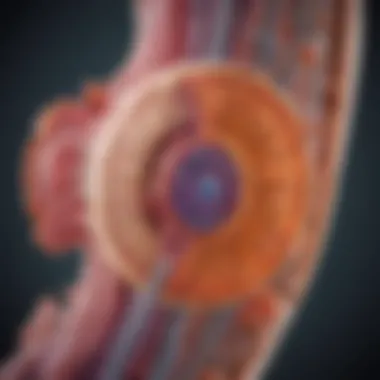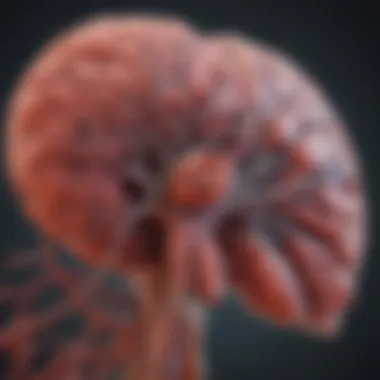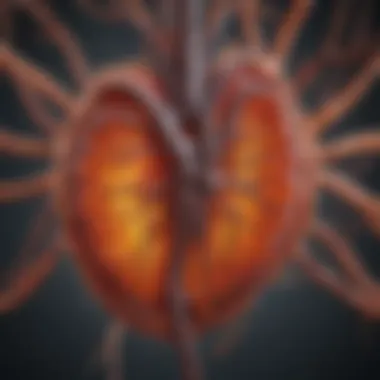Understanding Fibrotic Kidney: Mechanisms and Advances


Intro
Kidney fibrosis is becoming a growing concern in chronic kidney disease (CKD). It refers to the excessive accumulation of extracellular matrix components, leading to structural damage and dysfunction of the kidney. Understanding the mechanisms behind fibrotic kidney is crucial for developing effective therapeutic strategies. This article aims to present a thorough investigation of the pathophysiology, clinical implications, and the latest research advancements in this domain.
Chronic kidney disease affects millions of people globally. It leads to various complications, and fibrosis is often a key player in disease progression. The focus here is not only on the underlying mechanisms but also on how these processes impact patient outcomes and the overall treatment landscape. In addition, the discussion will highlight current research efforts that strive to address these challenges, paving the way for future therapeutic innovations.
Prolusion to Fibrotic Kidney
Kidney fibrosis is a critical aspect in the evolution of chronic kidney disease. This topic warrants attention due to its implications on renal function and patient outcomes. As nephrology evolves, understanding the nuances of kidney fibrosis can directly benefit treatment approaches. Kidney fibrosis presents a major challenge for healthcare professionals, researchers, and patients alike. It emphasizes the need for early diagnosis, effective management strategies, and ongoing research.
Definition and Importance
Fibrotic kidney refers to the pathological accumulation of extracellular matrix proteins, resulting in the scarring of the kidney tissue. This condition disrupts normal kidney architecture and function, ultimately leading to progressive renal impairment. The importance of understanding this condition lies in its association with various kidney diseases. Recognizing the stages and severity can facilitate timely interventions, thereby improving patient prognosis. A significant amount of morbidity and mortality can be associated with untreated kidney fibrosis, thus stressing the importance of proactive management.
Historical Perspective
The concept of kidney fibrosis has evolved significantly. Early studies focused primarily on the anatomical changes observed in renal tissues; however, contemporary research emphasizes the cellular and molecular mechanisms driving fibrosis. In the past thirty years, there has been a shift towards recognizing kidney fibrosis as a central element in chronic kidney disease progression. Landmark studies have identified various risk factors such as hypertension and diabetes mellitus that contribute to the fibrotic process.
Moreover, the identification of specific biomarkers associated with fibrotic kidney disease marks an important advancement. Initially, research concentrated on histopathological examination, but now there is a broader focus encompassing molecular pathways involved in fibrogenesis. This historical context underpins the urgency of exploring current and future research trajectories in this field, emphasizing both the progress made and the challenges that still prevail.
Pathophysiology of Kidney Fibrosis
The pathophysiology of kidney fibrosis is a crucial area of study that informs both clinical practice and research pursuits. Understanding these mechanisms is essential for advancing knowledge of chronic kidney disease progression. Fibrosis is not a standalone condition; rather, it can arise from several underlying pathologies. Comprehending the cellular events that lead to fibrosis helps in identifying potential intervention points for both diagnosis and therapy.
Cellular Mechanisms
Cellular mechanisms play a vital role in the development of kidney fibrosis. Key cell types involved include renal epithelial cells, myofibroblasts, and macrophages. In response to various stimuli, such as injury or stress, renal epithelial cells can undergo a process termed epithelial-to-mesenchymal transition (EMT). This transition results in the activation of myofibroblasts, which are crucial for producing collagen and other components that make up the extracellular matrix (ECM).
Myofibroblasts are differentiated fibroblasts that have enhanced proliferative and secretory capabilities. They take center stage in the fibrotic response by synthesizing excessive ECM, ultimately leading to scarring and loss of normal kidney structure and function. The activation of these cells is often mediated by transforming growth factor-beta (TGF-β), a potent fibrogenic cytokine.
One recent study suggested that targeting TGF-β signaling could mitigate renal fibrosis and restore kidney function.
Extracellular Matrix Remodeling
Extracellular matrix remodeling is another critical component of kidney fibrosis. The ECM is a complex network that provides structural support to tissues, regulating cell behavior and function. In kidney fibrosis, there is an imbalance between ECM production and degradation, leading to excess accumulation of fibrous tissue.
Several matrix metalloproteinases (MMPs) and their inhibitors (TIMPs) are involved in this process. MMPs break down components of the ECM, while TIMPs regulate MMP activity. Dysregulation leads to an increase in collagen types I and III deposition, resulting in stiffening of the renal parenchyma. This change significantly impacts kidney function, contributing to deterioration seen in chronic kidney disease.
Inflammation and Fibrogenesis


Inflammation is intricately tied to fibrogenesis, contributing significantly to the progression of kidney fibrosis. Inflammatory cells, particularly macrophages, accumulate in response to tissue injury, leading to the release of cytokines and chemokines. These signals perpetuate a cycle of inflammation and fibrogenesis, exacerbating the fibrotic response.
The inflammatory milieu not only recruits additional immune cells but also promotes the activation of resident fibroblasts. Inflammatory cytokines such as interleukin-1 (IL-1) and tumor necrosis factor-alpha (TNF-α) are known to activate pathways that drive fibrosis. Therefore, managing inflammation effectively could be pivotal in slowing the fibrosis progression in chronic kidney disease.
Clinical Implications
Understanding the clinical implications of fibrotic kidney is critical for both healthcare providers and patients. The presence of kidney fibrosis profoundly affects a patient's health status and can lead to a variety of complications. Recognizing the significance of this condition facilitates timely diagnosis, appropriate management, and ultimately better patient outcomes.
Diagnosis of Fibrotic Kidney
Correct diagnosis of fibrotic kidney relies on a combination of clinical observations, advanced testing, and imaging techniques. Identifying fibrosis at an early stage can help in preventing the progression of chronic kidney disease (CKD) and can guide therapeutic interventions. This makes accurate diagnosis particularly beneficial in clinical settings where the renal function is compromised.
Symptoms and Diagnostics
Laboratory Tests
Laboratory tests play a central role in assessing kidney function and evaluating for fibrosis. Blood tests, such as serum creatinine and urea levels, help determine kidney function impairment. Moreover, urine analysis can reveal abnormalities such as proteinuria, which may indicate kidney damage. These tests are essential since they provide a baseline assessment of kidney health and help monitor disease progression.
The key characteristic of laboratory tests is their ability to detect metabolic disturbances caused by renal issues. For instance, the presence of elevated creatinine levels suggests that the kidneys may not be filtering properly. Laboratory tests are popular due to their accessibility and cost-effectiveness compared to other diagnostic methods.
However, one disadvantage of laboratory testing is that they may not be specific enough to distinguish fibrotic changes from other forms of kidney injury. Thus, results should be interpreted carefully, considering the clinical context.
Imaging Techniques
Imaging techniques are vital for visualizing the structural and functional changes in the kidneys as fibrosis progresses. Ultrasound is often the first line of imaging due to its non-invasive nature and availability. It can provide information on kidney size and detect any obvious abnormalities.
A key characteristic of imaging techniques like magnetic resonance imaging (MRI) or computed tomography (CT) scans is their ability to create detailed images of kidney tissues. These methods are beneficial in assessing the extent of fibrosis and aiding in the differential diagnosis of renal conditions.
The unique feature of imaging techniques lies in their capacity to offer insights into the biological processes behind fibrogenesis. While CT scans may provide clearer images, they expose patients to radiation, which is a disadvantage compared to ultrasound. Therefore, the choice of imaging technique should align with the clinical scenario and patient safety considerations.
Complications Associated with Fibrosis
Fibrosis can lead to significant complications in patients, including but not limited to end-stage renal disease, cardiovascular problems, and metabolic disorders. As chronic kidney disease progresses due to fibrosis, patients may require dialysis or kidney transplantation, which are demanding procedures with varying success rates. Furthermore, fibrosis can exacerbate existing health conditions, leading to a decline in overall quality of life. Understanding these complications underscores the need for proactive management strategies aimed at slowing down the fibrotic process.
Types of Fibrotic Kidney Disease
Understanding types of fibrotic kidney disease is crucial in the diagnosis and treatment of chronic kidney conditions. This section discusses various forms of kidney fibrosis and their implications on both patient outcomes and therapeutic strategies. By exploring this topic, we can appreciate how different fibrotic processes shape the progression of kidney diseases and the strategies employed in management and research.
Acute vs Chronic Fibrosis
Acute and chronic fibrosis represent two distinct phases in the development of kidney damage. Acute fibrosis typically arises from sudden injury or infection and may resolve if the underlying cause is addressed promptly. In contrast, chronic fibrosis develops gradually over years. It results from repetitive insults to kidney tissue, leading to a progressive decline in kidney function. The distinction between these two types helps clinicians tailor the management approach for patients, focusing on early intervention for acute conditions while providing supportive care for chronic cases.


Specific Conditions Leading to Fibrosis
Fibrotic kidney disease can be triggered by several specific conditions. Identifying these conditions is essential for understanding the underlying mechanisms of kidney fibrosis and its management.
Diabetic Kidney Disease
Diabetic kidney disease is a major contributor to kidney fibrosis. High blood sugar levels lead to a range of biochemical alterations that promote fibrosis. One key characteristic is the excessive production of fibronectin and collagen, which disrupts normal kidney architecture. This condition is significant in this article as it exemplifies how systemic diseases can impact renal health. The unique feature of diabetic kidney disease is its potential reversibility if managed early with appropriate treatment, such as blood sugar control and lifestyle modifications. This makes it a popular focus in interventions aimed at halting or reversing kidney damage.
Hypertensive Nephrosclerosis
Hypertensive nephrosclerosis occurs due to long-term high blood pressure, leading to structural changes in the kidney. The key characteristic of this condition is the thickening of blood vessel walls alongside fibrosis of the kidney tissue. It is included in this article because hypertension is a common and modifiable risk factor. The unique aspect of hypertensive nephrosclerosis is its gradual progression, often unnoticed until significant renal impairment occurs. Understanding this condition is critical for developing preventive measures and therapeutic strategies, reducing the burden of chronic kidney disease.
Chronic Glomerulonephritis
Chronic glomerulonephritis is an inflammatory condition that affects the kidney's glomeruli. This condition leads to scarring and fibrosis as the inflammation persists. A vital characteristic is the immune response that plays a role in the disease's progression. It is beneficial to include this in the discussion as it highlights the multifactorial nature of kidney diseases. The unique feature of chronic glomerulonephritis is its variable presentation, which means diagnosis can be challenging. Understanding this disease can help researchers develop targeted therapies to address the inflammation and resultant fibrosis.
"Recognizing the specific types of fibrotic kidney disease is essential for optimizing patient care and research outcomes."
Each of these conditions serves as a marker for understanding the impact of kidney fibrosis on overall health. By highlighting these distinct forms of fibrosis, we underscore the need for tailored interventions and ongoing research that address specific pathological processes.
Current Therapeutic Approaches
The exploration of effective therapeutic strategies for kidney fibrosis is crucial for improving patient outcomes and managing chronic kidney disease. Various treatment modalities exist that target different aspects of fibrotic processes. These approaches can reduce symptoms, halt progression, and even reverse some pathological changes. Understanding these therapeutic avenues is essential for patients, clinicians, and researchers alike.
Medications for Fibrosis Management
Antifibrotic Agents
Antifibrotic agents serve a significant role in the management of kidney fibrosis. These medications aim to counteract the fibrotic process, slowing down or reducing scar tissue formation. A key characteristic of antifibrotic agents is their ability to modulate fibroblast activity. This modulation is essential, as fibroblasts are central to collagen deposition and extracellular matrix remodeling in fibrosing conditions.
One of the popular choices in this category is Pirfenidone. It has shown effectiveness by reducing collagen synthesis and promoting fibroblast apoptosis, thus preventing the excessive accumulation of extracellular matrix. The unique feature of antifibrotic agents like Pirfenidone is their potential in both acute and chronic settings. While they have evident benefits, it is important to monitor patients due to possible adverse effects, which may include gastrointestinal disturbances or liver enzyme abnormalities.
Immunosuppressive Drugs
Immunosuppressive drugs play a crucial role in managing conditions that lead to kidney fibrosis, particularly in autoimmune and inflammatory diseases. These drugs help in dampening the immune response, which can otherwise exacerbate kidney damage and subsequent fibrosis. A prominent choice in this category is Mycophenolate mofetil.
This medication's key characteristic lies in its ability to inhibit lymphocyte proliferation and reduce the production of specific antibodies. This makes it a beneficial option for patients with certain conditions, such as lupus nephritis. Mycophenolate mofetil's unique feature is its targeted action on the immune system rather than directly on fibrotic processes. However, the downside includes increased susceptibility to infections and potential gastrointestinal side effects, which requires careful patient selection and monitoring.
Innovative Therapies and Clinical Trials


As the landscape of research evolves, innovative therapies and clinical trials are becoming increasingly important in the fight against kidney fibrosis. Researchers are exploring advanced therapies that aim for better targeting of fibrotic pathways. For example, gene therapy and advanced biological agents are being investigated.
Clinical trials are focused on determining the safety and efficacy of these new therapies. These trials not only help in establishing new treatment guidelines but also give hope for more effective outcomes for patients suffering from fibrotic kidney conditions. Continued engagement in clinical research and trials is of utmost importance in reshaping the management of kidney fibrosis.
Research Advances in Fibrotic Kidney
Research advances in fibrotic kidney disease are critical for improving our understanding of this complex condition. They provide insights into the underlying mechanisms that promote kidney fibrosis, which is a significant factor in the progression of chronic kidney disease. Continuous exploration in this area uncovers new pathways, genetic factors, and potential therapeutic targets that can inform clinical practices and treatment strategies. The research findings not only guide physicians in managing the condition but also help in developing patient-centered approaches to care.
Recent Discoveries and Innovations
Recent studies have shed light on several innovative discoveries related to kidney fibrosis. One notable area of focus is the identification of specific biomarkers that indicate the presence and progression of fibrosis. These biomarkers, such as transforming growth factor-beta (TGF-β), play a key role in the fibrogenic process. They facilitate the activation of fibroblasts and contribute to extracellular matrix accumulation.
- Gene editing technologies, like CRISPR, have made it possible to manipulate genes associated with fibrogenesis. By targeting genes that drive fibrosis, researchers can explore potential avenues for therapy.
- Furthermore, cell-based therapies that utilize mesenchymal stem cells are being evaluated for their antifibrotic properties. Early-stage clinical trials have shown promise in reducing renal fibrosis by influencing local immune responses and promoting tissue repair.
- Understanding the role of the gut microbiome in kidney health has gained attention. Alterations in the gut flora may impact inflammatory responses and kidney function, offering a new therapeutic angle.
These discoveries highlight the dynamic nature of research in this field and underscore the innovative strategies that may transform the management of kidney fibrosis.
Future Directions in Research
Despite the progress made, several challenges and opportunities remain in the research landscape of fibrotic kidney disease. Future directions can focus on several avenues:
- Enhanced understanding of the heterogeneity of kidney fibrosis will allow for more tailored treatment approaches. Studies should aim to categorize patients based on genetic, molecular, and clinical profiles that influence their response to therapies.
- Continued exploration of novel antifibrotic agents is essential. New drug candidates, such as various tyrosine kinase inhibitors, are currently in development and warrant rigorous clinical trials to evaluate their efficacy and safety profiles.
- Investigation into lifestyle factors, such as diet and exercise, can also provide insight into their preventative roles against the onset of kidney fibrosis. Longitudinal studies may elucidate the effect of lifestyle modifications on disease progression.
- Integrating advanced imaging techniques with molecular pathology can enhance our ability to visualize fibrotic changes in real-time, enabling timely interventions.
Lastly, fostering collaboration among multidisciplinary teams, including nephrologists, researchers, and patients, will be vital. A coordinated effort can leverage diverse expertise and insights, paving the way for breakthroughs in understanding and treating fibrotic kidney disease.
"Understanding these research advances not only informs clinical practices but also empowers patients in managing their conditions."
Finale
The conclusion of this article serves as a pivotal opportunity to encapsulate the multifaceted nature of fibrotic kidney disease and its significance in the landscape of nephrology. Understanding this condition is paramount not only for the medical community but also for patients and researchers. With the rising prevalence of chronic kidney diseases, awareness regarding the mechanisms and impacts of kidney fibrosis becomes increasingly crucial.
Summary of Key Points
Throughout the article, key themes were explored that illuminate the nuances of fibrotic kidney disease:
- Pathophysiology: The cellular mechanisms, extracellular matrix remodeling, and the role of inflammation were highlighted as fundamental processes leading to kidney fibrosis.
- Diagnosis: Methods for identifying fibrotic kidney conditions include various laboratory tests and imaging techniques, essential for early intervention and management.
- Therapeutic Approaches: The article outlined current medications such as antifibrotic agents and immunosuppressive drugs, alongside innovative therapies emerging from ongoing clinical trials.
- Research Advances: Recent discoveries provide new insights into fibrogenesis and potential pathways for future treatments, underscoring the importance of continued research in this field.
This synthesis brings to light that a comprehensive understanding of fibrotic kidney disease not only benefits clinical practices but also enhances research development, paving the way for novel treatment strategies.
Call for Continued Research
The domain of fibrotic kidney disease is an evolving one, with much still to explore. The call for continued research is critical; not only must we decode the pathology of fibrosis, but we also need to refine therapeutic interventions. Ensuring funding and resources are allocated toward this area is essential. The development of antifibrotic therapies and innovative methodologies will significantly impact the prognosis and quality of life for patients suffering from related conditions.
"Continued investigation into molecular targets and the engagement of multidisciplinary teams will foster advancements in fibrosis management."
Focusing on collaborations between researchers and clinical practitioners may yield significant breakthroughs. Engaging in discussions within the community, including forums like Reddit and professional organizations on platforms like Facebook, can facilitate a greater understanding of the complexities surrounding fibrotic kidney disease.
As we progress, addressing the gaps in knowledge and application through rigorous research will be the cornerstone for effective healthcare strategies. The implications of our understanding hold transformative potential for improving outcomes in chronic kidney disease.







